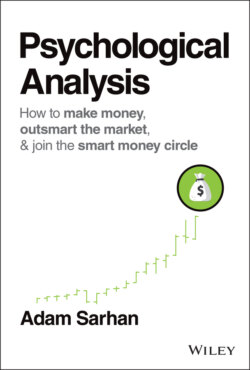Читать книгу Psychological Analysis - Adam Sarhan - Страница 29
PAPER TRADING
ОглавлениеWithout realizing it, I turned into a learning machine. At every waking moment, I was reading about the market and trying to apply what I learned. Because I was buried in debt and had no money, I could not actively trade in the market. Instead, I wrote a daily and weekly “newsletter,” which covered my thoughts about the market, what stocks to buy and sell, where to enter and exit each trade, and how much to risk when the trade went the wrong way. Basically, I wanted to get my ideas out of my head and put them on paper so I could have accountability and actually track my ideas. I started a paper trading account—essentially a ledger of when I would have bought and sold—so I could track how I would have done if I had been working with real money. There's a benefit to trading with fake money—you're not emotionally attached to what happens; this way your emotions do not infect your decision‐making process. But the downside to paper trading is that when real money is on the line, your emotions are involved, and everything changes. So your real‐world results are rarely the same as your paper trading results.
During the early paper trading days, I lost a lot of fake money, but the more mistakes I made, the more I learned, and I wasn't paying the painful “market tuition” price that marked my very first experiments with the market.
Looking back, now that I'm in the smart money circle, the mistakes I made seem mind‐boggling. I had no discipline. I failed to respect risk. I jumped from one shiny object to another. I did not understand portfolio management. I did not follow a time‐tested strategy—or any rules at all for that matter. Basically, I made every beginner mistake you can think of and struggled for years.
After what felt like an endless, painful parade of failures, I decided I needed a well‐thought‐out coordinated system for researching investment ideas, developing strategies, and testing those strategies in the market with my paper trading accounts. It turns out someone had already developed that system. It's called “the scientific method.”
Just in case it's been awhile since you participated in a high school science class, here's a quick refresher on the scientific method:
Scientists ask a question about the nature of the universe;
They conduct research to see what data exists on the subject;
They propose a hypothesis;
They design an experiment to test their hypothesis;
They collect and analyze the data; and then
They draw conclusions and share their results.
Having just rediscovered the scientific method, I began organizing my research and documenting the strategies, and I was eager to start seriously testing my ideas in the market. Because sharing results is part of the scientific process, I decided to write a stock market newsletter, where I would publish my ideas and track my results, pretending that I had $1,000,000 under management (which at the time, I mistakenly thought was all the money in the world). That number seemed inconceivably high to me at the time. If it seems inconceivably high to you right now, keep reading, because that mindset is part of what's keeping you out of the smart money circle (and you can change it!).
As time passed, I started to study which strategies tended to win and which would lose.
At first, I published the newsletter, which I titled The Green Machine, daily, but struggled because—another timeless lesson that I learned years later—most days are meaningless on Wall Street. Then I pivoted and started publishing the newsletter every weekend.
For me, I found that making my buy/sell decisions on a weekly basis gave me much‐needed structure and it best suited my trading style. After several months of maintaining the weekly discipline, I started posting some pretty solid gains. After a few years, by 2007, I had an average annualized return of 21%, and my deepest drawdown was 9%. That wasn't bad for a kid who started out with nothing!
